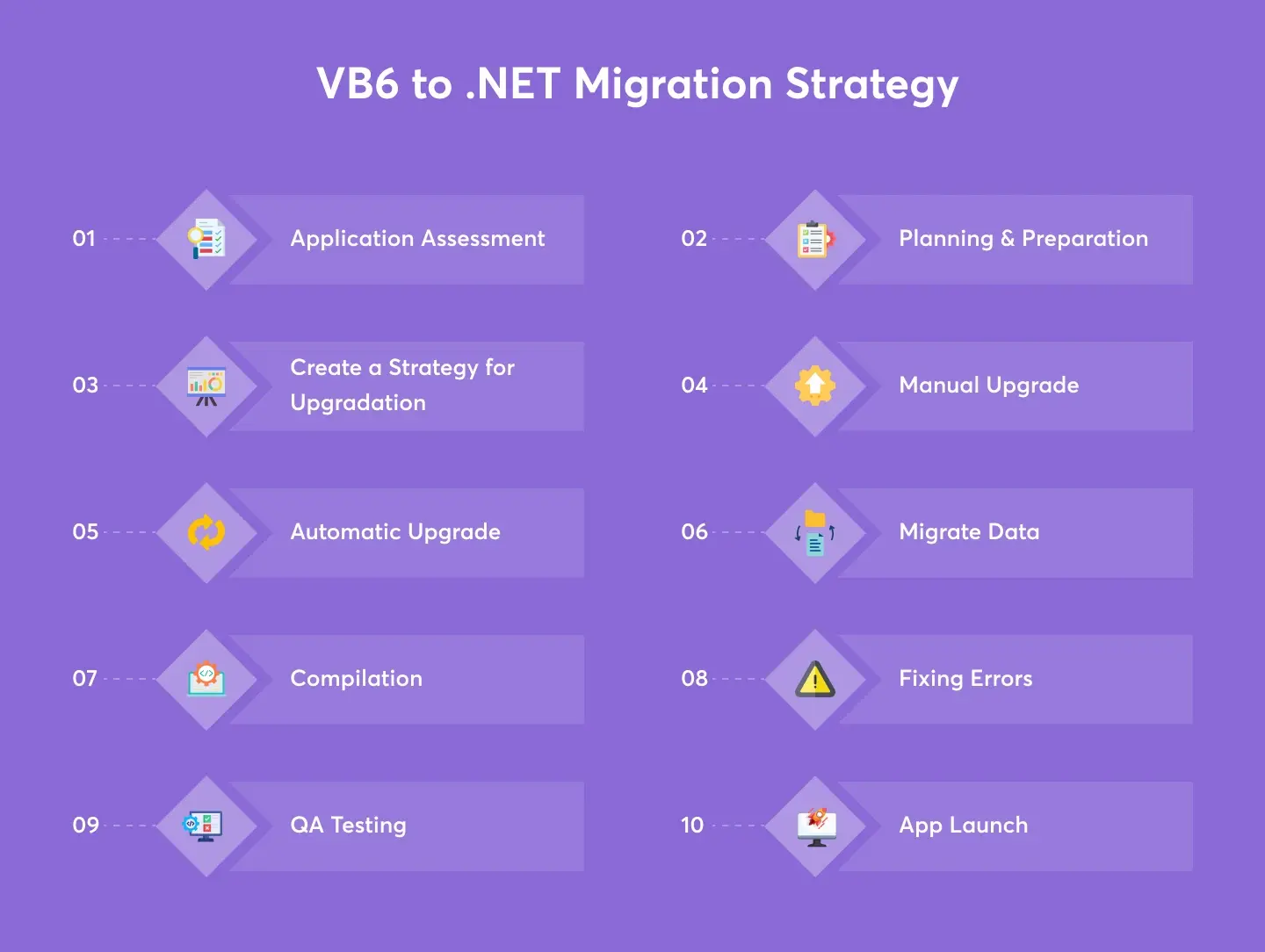VB6 to .NET Migration: Challenges and Solutions
Migrating software comes with challenges, but they have solutions if it is done by professionals and expert software modernization agencies. We have explained software migration challenges, especially with VB6 to .NET Migration.
Are you thinking of VB6 to .NET migration but don’t know how to deal with its associated challenges? Nodded? Then, you’re at the right place. In this article, we are going to drive you through a comprehensive guide on VB6 to web migration, especially to .NET, with which you’ll have a complete grasp on every aspect related to this topic, like challenges, solutions, and strategy.
No matter whether it’s a small business or an enterprise one, using software now is a must-have for businesses of all sizes. Owing to the need, those with legacy software modernize their legacy system to catch up with market needs. However, most of them don’t know how to make the most out of trending technologies.
The majority of organizations are still getting their system run on technology like VB6, which is outdated. If you’re one of those, it’s time to make the right decision and consider VB to .NET migration, which will be the right choice for a streamlined business operation.
We have vast experience in migrating legacy systems, like VB6, to modern technology and platforms. It includes Desktop to web platforms, VB6 to .NET Core, React Native, and more you want. Contact Us to know how our synergy works.
Let’s dig deeper!
What are VB6 And .NET?
VB6 is the last and 6th version of Visual Basic Language that’s used to create software solutions. VB (Visual Basic) is one of the oldest programming languages, introduced by Microsoft in the 90s. Unfortunately, the platform is no longer being provided any updates by Microsoft, causing it to be an obsolete technology that’s vulnerable to cyber-attacks.
.NET, on the other hand, is a development platform backed by Microsoft used to create high-performance software solutions. Unlike VB6, Microsoft offers continuous assistance to create, maintain, and update .NET with the current and trending development tools, security mechanisms, and industry standards.
Engineers prefer .NET for building platform-agnostic software solutions that are operable on Windows, macOS, and Linux on mobile desktops or even browsers. Apart from that, developers with .NET can make use of multiple languages, for instance, F#, C#, Visual Basic, and the like.
Why Should You Convert VB6 Project to .NET?
In this immensely digitized era, businesses are unstoppably rushing towards online platforms intending to expand their reach to wider customers and skyrocket their businesses. In order to manage digital operations well-mannerly, a robust and secure system is a must-have. As VB6 is no longer in trend, migrating VB6 or VB.NET apps to .NET is a perfect choice for better performance. Glance at the pointers below to get reasons why you should convert the vb6 project to .net!
- VB6 is an obsolete technology, and security researchers happen to find plenty of vulnerable loopholes day in and day out, says CVE reports.
- Every VB6 vulnerability score 9.3, which breach can have immense consequences on an organization’s reputation along with its capital.
- Apart from that, the VB6 isn’t receiving continuous updates from Microsoft.
- The technology isn’t capable of handling object-oriented programming, exception handling, and multi-threading, which can cause slowing down the performance of applications running on VB6.
- .NET, on the other hand, is used by around 2.9% of all websites worldwide.
- Furthermore, a gargantuan share of businesses across the globe prefers to employ the latest technologies over old ones for their internal as well as external business operations.
While VB6 is an obsolete technology that Microsoft no longer supports, .NET is a trending technology that is getting appropriate and frequent support from Microsoft. Dotnet ensures an end-to-end solution for businesses; hence, they prefer it over many other technologies.
What are The Benefits of Choosing .NET over VB6?
As we had a brief glance at the basics of .NET and VB6, and learned why you should migrate vb6 to .net, now is the time to be more precise about the benefits it brings to the table. Here are some of the benefits that you embrace when you migrate vb6 to vb net!
- .NET has live support from Microsoft.
- It’s backed by a wider community of software developers and researchers.
- The platform is an open-source development environment enabling you to make use of it as per your business needs.
- .NET offers you a wide variety of plugins and APIs that you can conveniently implement into your .NET application with no need for any third-party solutions 0r any external tool.
- Access to the NuGet package manager offers you over 90,000 packages that you can use for application development.
- Using .NET, you can perform desktop, mobile, web, Microsoft, cloud, IoT, machine learning, and game development.
Note: You must bear in mind that the VB6 is far behind .NET. The former has no comparison with the latter in terms of offering advantages.
VB6 to .NET Migration: Select the Right Approach Suitable to Your Needs
Before heading to probate more like challenges and solutions, let’s first know the approaches to VB6 to .NET migration. Here are the three approaches that we discuss one by one!
Extension
Choose the Extension approach if your existing application performs right and you’re in need of creating additional features with less expense and effort. You can bring .NET modules from inside the old application, leaving a legacy system as it is but implementing additional elements using a modern framework. Besides, the very modules in the old application which are still relevant to the business can also be migrated to the .NET. This approach is popularly known as the “strangler” pattern.
Advantages of the Extension approach:
- It is converted gradually.
- It’s cost-effective in the long run.
Disadvantages of the Extension approach:
- There’s a risk of business continuity. The part of Visual Basic would be prone to issues until they get migrated entirely.
Migration
Choose the Migration approach when your old application isn’t stable, exasperates your users with continuous errors, and at times even causes work loss. The Migration approach for VB6 to .NET migration is likely to be started with automated converters. It takes VB codes and translates them to C# .NET.
Advantages of the Migration Approach:
- Migration is another cost-effective approach after Extension.
- The entire app will be free from every kind of stability and security issue.
Disadvantages of the Migration Approach:
- You need to create the base application before adding new functionalities.
- Poor architecture might be inherited from the existing code.
Rewriting
This one is another approach to VB6 to .NET migration which requires a complete rewriting of the .NET framework. Choose this one when the existing application is entirely outdated and isn’t able to satisfy your business needs. This will help you embrace an expensive market share.
Advantages of the Rewriting Approach:
- It changes the platform to mobile and web.
- Architecture writing from the get-go, making use of a modern approach, enables cost-effective improvements and development.
- Ensures more reasonable ongoing support in the long run.
Disadvantages of the Rewriting Approach:
- The rewriting approach requires a huge investment compared to the previous two approaches.
- The rewritten functionality should be comprehensively tested to ensure compliance with the old behavior.
What are VB6 to .NET Migration Challenges?
When you convert a vb6 project to vb .net, you’re more likely to come across various challenges. These challenges include conducting code audits, bug fixing, application improvement, choosing the right software migration services provider to work on the project, and so on.
Code Audit
It’s always a good software migration best practice to conduct a code audit before migration; hence, it’s the first challenge associated with vb6 to .net migration. When you’re to conduct a migration, cleaning up the code beforehand will save you a huge chunk of money and time associated with the migration procedure, making the process way more convenient and cost-effective.
Quality Control
Quality Control is another challenge of VB6 to .NET migration. If you’re aware of the fact that your code isn’t clear or is affected by many bugs, you better consider selecting the rewriting migration approach. This is because if you migrate a lower quality code VB6 to .NET, you’ll be likely to spend an enormous amount of time fixing bugs, ending up investing time and budget for no reason.
Third-Party Control Check
It’s another challenge that you may encounter while vb6 migration. Visual Basic makes use of third-party controls that aren’t compatible with .NET. In case you continue to use them, you’ll end up mitigating the speed and performance of your application to a massive extent.
Bug Fixing
The next one is a bug fixing beforehand. Being prepared before you consider VB6 to .NET migration will assist you in lessening the number of bugs you encounter. So, make sure you don’t procrastinate bug fixing to give your users a quality experience when they engage with your application.
Application Improvement
Another challenge when you migrate vb6 to the net is to improve the application after migration. You need to make sure the app isn’t outdated and it provides solutions for comprehensive business requirements. So, ensure you’ve made all improvements by fixing them or implementing even additional functionalities if needed.
Right team
Last but not the least! Having the right team to work on a project has a significant influence on how outcomes will be. However, the VB6 to .NET migration is a complex procedure; it has a multitude of benefits to offer when done right. So, make sure you own a team that’s embellished with talented .NET experts with dexterity in conducting full-fledged migration procedures.
VB6 to .NET Migration Strategy: An Effective Solution to Troubleshoot Challenges Associated with Migration

As we’ve done a complete assessment of almost every aspect relating to the Vb6 to .net migration, now it’s time to come to our key discussion point and discuss the strategy for VB6 to .NET migration. Here’s a complete strategy that you should follow for a successful migration!
Application Assessment
The first step of the complete strategy, when you migrate vb6 to vb net, is the assessment of the existing vb6 application. However, proper legacy software assessment can be a daunting task; when you do it, you’ll have plenty of pluses. You can do it manually, or you can make use of tools as well for analysis. Irrespective of which way you follow, you’ll end up having a complete grasp of the issues and requirements, hence, will be able to estimate the effort associated with migration. Besides, you’ll also be able to know how much it costs to migrate your legacy software to .net.
Planning & Preparation
Now, you’ve entered the second phase of the strategy, which is planning and preparation. Make use of the assessment of existing applications you did before, brainstorm the type of application you want post-migration, and then plan for further execution, determining scope along with the migration needs. Accumulate all the tools and resources, form a team, and ensure the entire team works in unison towards a centralized goal to achieve it.
Create a Strategy for Upgradation
Create a strategy to migrate once you have brainstormed and created documentation for the app requirements. First off, you have to get the VB6 application into the .NET platform as it is. After that, make incremental alterations to incorporate new features and functionalities.
There’s a multitude of ways using which you migrate the app, and more than one of those are likely to be utilized in different forms in the various states of migration. However, it’s right to plan beforehand; you need to be flexible enough when it comes to addressing even-changing requirements.
Manual Upgrade
Consider rewriting application logic to fit into the .NET framework as well as those which haven’t been converted completely during automation. You can continue writing new code in VB.NET, leaving the existing code behind, as there’s good interoperability between VB.NET components and VB6 COM components.
Automatic Upgrade
Once the migration gets done, the quality of the generated code requires optimization. The process consists of the complete removal of existing code, the upgradation of problematic syntax and controls, as well as fixing data declaration. The automation procedure is likely to yield code with the quality equivalent to the previous code. Furthermore, automated changes tend to be cosmetic and may not be complete needing to be intervened manually.
Migrate Data
This is another step of the strategy to VB6 to .NET migration which consists of yielding a SQL Server or database as well as importing data and then resizing the structure of the database. Optimization and resizing of the data ensures enhanced performance of the application.
Compilation
The next step to migrating vb6 to .net is compiling. It provides a list of compilation and runtime errors that need to be assessed and fixed by the developers abiding by the reiterative procedure.
Fixing Errors
Now, conducting bug fixing is another step. You can track bugs by making use of different source code analyzers that will assist you in recognizing duplicate codes and troubleshooting the data declaration. You need to conduct development and bug fixing synchronously as new codes are converted. The testing process requires to be done by a team separate from those who work on the migration.
QA Testing
When the migration gets done, the application requires to be tested for quality assurance. A migrated application is subjected to be tested at a variety of levels throughout the process, which includes the correctness of the performance and the reliability of the application. The process of QA testing is similar to development. Consider end-to-end testing for each component and identify the bugs in the implementation. Besides, don’t forget to conduct system testing to make sure the app functionalities align with the .NET framework version.
App Launch
Now, you’re almost done, so consider app launch to the app server and verify the checklist of components and functionalities to ensure a better user experience.
Conclusion:
That’s all there’s to it! That’s all about the challenges and solutions for VB6 to .NET Migration. We discussed everything, including VB6 and .NET, with the reasons, advantages, and disadvantages of why to migrate vb6 to .net, and so on. After these, we had a look at the challenges and the strategy of converting vb6 to .net. Hopefully, you’ve got the most out of this article. If you need to migrate your app, feel free to get in touch with the best VB.NET migration service provider to leverage a complete migration solution with ease.
FAQs
Yes! VB6 (Visual Basic 6) is a programming language introduced by Microsoft in 1998 for creating Windows apps, but it is obsolete now.
Confirming that Visual Basic will be an ongoing concern, Microsoft updated its strategy of the programming languages; however, but unfortunately, VB is still being degraded when compared to C# and F#. So, it isn’t being used as the first preference by users.
VBA is the most popular type of Visual Basic in use today. It’s used to create applications for Microsoft Office, for instance, PowerPoint and Excel.
Want to
Convert VB6 to .NET Framework?Our Expertise
- 20+ Long-term projects
- 60+ Standard projects
- 11+ Yrs into Migration







 Kevin Bhut
Kevin Bhut 







